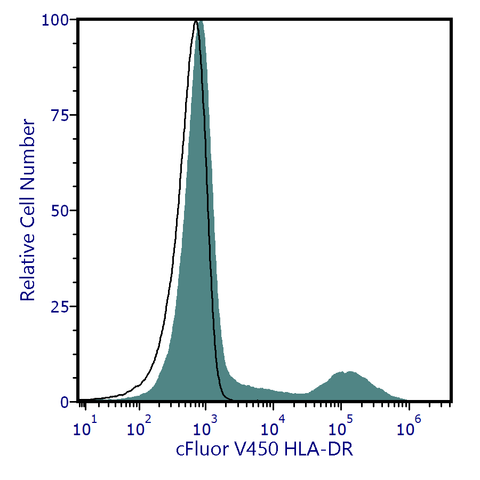
cFluor® V450 Anti-Human HLA-DR (L243)
View Cart or Continue shopping.
Description
The monoclonal antibody clone L243 binds to the human HLA-DR antigen, a 36-kDa alpha heavy chain, and a 27-kDa beta light chain heterodimeric cell surface glycoprotein in the transmembrane major histocompatibility complex 2 (MHC II) family. HLA-DR, also known as human leukocyte antigen DR isotype, is present on the surface of antigen-presenting cells, including B cells, dendritic cells, macrophages, monocytes, and activated T cells. MHC class II regulates the immune system by playing a critical role in binding and presenting antigen-derived peptides to peptide-MHC II-specific CD4 T cells. The L243 clone identifies HLA-DR molecules, whether peptide-loaded or unoccupied. It does not exhibit cross-reactivity with HLA-DP and HLA-DQ. Clone L243 interacts with a conformational epitope on HLA-DRα, contingent upon the proper folding of the αβ heterodimer.
PRODUCT DETAILS
Clone: L243
Specificity: HLA-DR
Reactivity: Human, African Green, Baboon, Chimpanzee, Cynomolgus macaque, Dog (Canine), Marmoset, Rhesus, Squirrel, Tamarin monkey
Format: cFluor® V450
Isotype: Mouse IgG2a, k
Tested Dilution: 5 µL / test
Application: Flow Cytometry
Storage: 2-8°C and protected from light. Do not freeze
Formulation: Phosphate-buffered saline, pH 7.2, containing 0.09% sodium azide and 0.2% BSA (BSA Country of Origin USA)
RECOMMENDED USAGE
Each lot of this antibody is quality control tested using flow cytometric analysis. For flow cytometric staining, the suggested use of this reagent is 5 µL per 1 million cells in a staining volume of 100 µL. If whole blood is analyzed, then use 5 µL per 100 µL. It is recommended that users titrate the antibody to obtain the optimal result for their specific application.
Please briefly centrifuge the reagent vial before use.
Use appropriate personal protective equipment per the product safety data sheet when using this product.
REFERENCES
- Knapp W. 1989. Leucocyte Typing IV. Oxford University Press New York.
- Barclay N, et al. 1997. The Leucocyte Antigen Facts Book. Academic Press Inc. San Diego.
- Marsik C, et al. 2003. Shock 20:493-6.; Yoshino N, et al. 2000. Exp. Anim. (Tokyo) 49:97-100.
For research use only. Not intended for use in diagnostic procedures.
